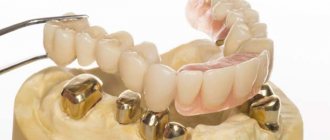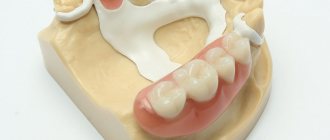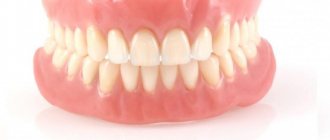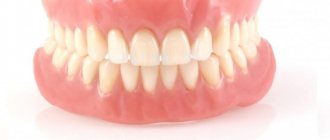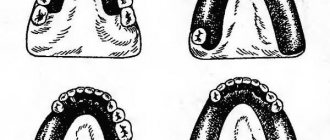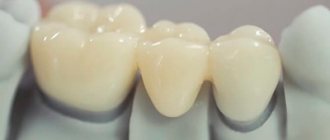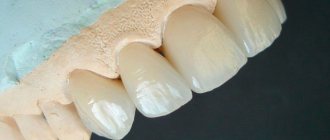What are clasp dentures and what do they look like?
These are removable structures used to restore included and terminal defects of the dentition. They are lighter and more comfortable than plate prostheses with a “sky”, and are in demand in cases where prosthetics on implants cannot be performed.
With the help of a clasp prosthesis, chewing function and aesthetics are restored both in the anterior and lateral sections of the jaw. In the smile zone, they most often use prosthetics from one to three consecutive teeth, and in the lateral sections - longer areas (3-5 missing teeth on one or both sides).
Externally, it is a simple design consisting of a metal arch and plastic imitation of gums with artificial teeth. The absence of a “sky”, characteristic of plate dentures, makes the clasp a lighter and more compact option. You get used to it faster and feel less discomfort. It does not interfere with conversation and is hardly noticeable in the mouth.
What is a clasp prosthesis and its types?
A clasp denture helps to normalize chewing function and restore attractiveness in a short period of time. It is used when part of the dentition is lost, as well as when for certain reasons it is impossible to install an implant or bridge. To understand what a clasp prosthesis looks like and how it should be used, just look at the finished product.
This is a removable structure made of artificial teeth with a base simulating gum, installed on a cast metal arch (clasp). Attaching clasp dentures is designed to fix the structure to crowns, healthy teeth or implants. The device helps to evenly distribute the chewing load throughout the jaw. Most often, fixation of clasp dentures is ensured with the help of clasps linked to the units in the installed position. The model does not have a palate characteristic of plate microprostheses. The design is compact, does not cause discomfort, and is practically invisible in the oral cavity.
Separate parts of the clasp prosthesis are included in all existing models. These include:
- Frame of a clasp prosthesis (arch). This is the base that performs the supporting function and holds together all the parts of the structure. It should follow the shape of the hard palate or alveolar area of the lower jaw;
- Fixing parts;
- The base part on which artificial teeth are placed.
To extend its service life, it is important to follow the rules of care and know how to remove a clasp prosthesis of a specific model.
Types of clasp dentures are classified depending on the material used to make artificial teeth (plastic or composite materials) and the method of fixation.
Methods for fixing clasp dentures
1. On clasps . They are considered budget designs. They are easily removed and are held on the supporting teeth with the help of flattened metal hooks - clasps. Clasps firmly hold the device in the mouth without damaging tooth enamel. Hooks are manufactured in accordance with the parameters of the supporting units. The clasp clasp prosthesis is strengthened only when it reaches the front side of the dentition and is noticeable during conversation, which is considered a disadvantage of this model.
2. On attachments (micro-locks). Fixation is carried out using micro-locks, invisible from the outside. The elements of a clasp prosthesis of this type are located as follows: one of them, the patrix, is located in the microprosthesis itself, the second, the matrix, is mounted in a metal-ceramic crown, which is put on the abutment tooth. Fixation is performed automatically when put on. There are rail, crossbar and spherical micro-locks. When asked which clasp prosthesis should be chosen and which is better, experts generally indicate the model on the attachments. It differs from the clasp type in its high aesthetic characteristics, it is compact, lightweight, and has a reliable fixation. The condition for establishing this type of device is the absence of periodontal tissue diseases and the presence of the required size of the coronal zone of the supporting part. The downside is the inevitability of grinding the supporting teeth.
3. On telescopic crowns . Fixation is done using composite crowns. The removable element is an artificial tooth with a cavity inside, and the supporting base is a stump turned to the appropriate shape, covered with metal on top. It is used in the absence of the majority of teeth, the smoothness and small size of the remaining fragments, as well as in the presence of chronic pathologies of periodontal tissues. The design is lightweight, has high aesthetic characteristics, and helps concentrate the load when chewing only on the supporting parts, thus reducing the likelihood of damage to the mucosa.
4. Splinting fastening . Splinting clasp prosthesis is used for periodontitis, the absence of a large number of teeth and the unstable condition of the remaining ones. A prerequisite for this is the presence of elements with the required height on which the structure will be attached. The arc of the clasp prosthesis of this model connects the caps (fixed part) and matrices (removable part). It is attached to healthy teeth from the inside using metal plates that accurately follow the shape of the teeth. Long-term wearing of the device does not spoil the enamel or damage the mucous membrane.
What does a clasp prosthesis consist of, what materials are used in its manufacture?
A modern clasp prosthesis, made from high-quality materials, looks quite aesthetically pleasing. It consists of four parts.
- Frame (clasp). Durable, thin and light. It includes: a cast arch that evenly transfers the load to the jaw in places of missing teeth, slowing down the processes of bone resorption;
- mesh for attaching artificial teeth, allowing you to create a single structure;
- fasteners (clasps, beam structures, telescopic crowns, anchor and magnetic clamps) for rigid, elastic or hinged fastening on supports (healthy teeth, implants, crowns);
- splinting elements (according to indications - claw-shaped hooks, clasps, Elbrecht splints).
Materials for making a prosthesis
- Frame, fasteners. Using classical technology, the base of the structure is made of metal using modern casting methods. Depending on individual tolerance and other criteria, alloys of noble metals, cobalt-nickel-chrome with minor impurities, as well as titanium are used.
Currently, there are more modern materials - thermoplastic polymers, which are not inferior in strength to metal, but are more elastic and comfortable. The most famous are ACETAL or Dental D from QuattroTi.
- Base. It is made using classical technology - hot polymerization from acrylic, and in modern versions, like the frame, from thermopolymers.
- Teeth. Plastic, composites.
The choice in favor of one or another material is determined by the individual sensitivity, wishes and financial capabilities of the patient.
Types of clasp clasp dentures
Clasps in clasp prosthetics act as fasteners; they wrap the abutment tooth and transfer the load to it, while simultaneously fixing the prosthesis. They can be made by two methods - they are either cast from metal or bent from wire. They are usually made of stainless steel or alloys based on gold. Clasps are divided into several types depending on the function they perform. They are:
- Supporting ones , which distribute the pressure from chewing food between the teeth and gums,
- Retaining - they sag under load to the mucous membrane and transfer pressure to it,
- Combined - these are support-retaining clasps that transfer a large load to the gums.
In addition, clasp dentures with clasp fixation are distinguished:
- in shape - they can be flat, ribbon, semicircular and round,
- according to the grip of the teeth - these are single-arm, double-arm, ring-shaped, single-link and double structures,
- According to the manufacturing method , there are cast and bent dentures.
Read a detailed description of all types of clasp dentures.
Pros and cons of clasp prosthetics
This type of replacement structure is the pinnacle of removable prosthetics. On the one hand, it can be used to restore a large number of lost teeth. On the other hand, even in difficult cases (for example, two teeth are missing in front, three on the right, and five on the left), this is still a light and comfortable prosthetic system.
The following are responsible for comfort during clasp prosthetics:
- a very thin arch that presses tightly against the palate when worn;
- reliable fasteners providing rigid fixation.
Thanks to this, the prosthesis does not play during conversation, chewing and is practically not felt by the patient. This is a truly reliable type of prosthetics.
The main advantages of clasp dentures
- Functionality. A rigid type of fixation with support not only on the gums, but also on the teeth, completely restores chewing function.
- Strength. The presence of a metal frame makes it possible to install prosthetic teeth even with severe violations of the integrity of the dentition.
- Hygiene. Depending on the type of fixation, clasp dentures are removable and conditionally removable. Some are easy to clean at home, while others can be cleaned during hygienic cleaning at the dental clinic.
- Durability. Durable modern materials and uniform load distribution make the prosthesis reliable, allowing it to be used for 5–10 years.
- Aesthetics. Correct selection of the shade of the polymer base and dental crowns makes the artificial part indistinguishable from the patient’s own teeth. Options with attachments, telescopic crowns and thermopolymers are invisible in the smile area.
- Bioinertness. Thanks to titanium, as well as modern thermoplastics, replacing lost teeth does not harm the body. The materials are hypoallergenic and do not interact physically or chemically with the oral environment. This means that the taste sensations are completely preserved.
- Convenience. The minimal size of the prosthesis (thin arch and only one layer of polymer) allows you to not feel it when wearing it, does not affect diction, does not cause discomfort or a gag reflex, so the prosthesis can be worn around the clock.
- Splinting. This type of prosthetics can be used even with loose gums and loose supporting teeth. Adding special splints to the frame will help keep the supporting teeth in the desired position, prolonging their life.
- Maintainability. In most cases, a prosthesis can be repaired if it breaks. Only some types of fasteners cannot be restored.
The production technology has been worked out to the smallest detail, and is optimal in terms of price and time. This is also an important advantage.
Disadvantages of clasp dentures
- High price. If we compare the clasp with a conventional plate prosthesis, the difference in price attracts attention. It is formed taking into account complex manufacturing technology and the use of expensive materials. This cannot be considered a real disadvantage, because better quality means additional comfort and aesthetics, as well as 2-3 times longer service life.
- Grinding teeth for crowns. In some cases, it may be necessary to prepare healthy tissue and remove the dental nerve to form a support.
- Not used for edentulous patients. In case of complete absence of teeth, our dentist will offer more cost-effective prosthetics using All-on-4 implants.
Cheaper options have additional disadvantages, including the effect of galvanization and allergies to metal, discomfort for 1–2 weeks during the adaptation period, less aesthetics of fasteners, as well as bone resorption, which can only be avoided by prosthetics on implants.
Advantages and disadvantages
The advantages of clasp dentures with clasps include:
- Do not change diction.
- Does not interfere with taste
- Without affecting sensitivity to temperature fluctuations
- Wear comfort
- Quickly addictive
- Reliable fixation of the prosthesis
- Load distribution is uniform throughout the entire prosthesis
But there are also disadvantages:
- Unaesthetic when touching the smile line
- Possible rubbing of gum clasps
- The whole structure has a high cost
Indications and contraindications for installation
The choice in favor of clasp dentures is made in the presence of dentition defects, both single (1-3 teeth - Quadrotti’s “butterfly”), and multiple – included and terminal bilateral.
Contraindications:
- metal allergy;
- complete absence of teeth;
- atrophic processes in the jaw;
- inflammatory diseases of the gums and periodontium;
- low height of supporting teeth, insufficient for prosthetics.
Many contraindications apply to classic metal prostheses. The use of technologically more advanced thermoplastic options expands the range of indications for installation.
Construction of the clasp prosthesis frame
The basis of clasp prosthetics is a frame made of heavy-duty material. As a rule, gold-platinum, chromium-cobalt and titanium alloys are used for its manufacture. Metal structures are the most common, but there are also metal-free prostheses, which are suitable for people with metal allergies, and plastic acetal prostheses.
The frame includes an arch connecting the right and left bases of the prosthesis. Bases are saddle-shaped parts of a prosthesis that imitate gums and hold artificial teeth, supporting and connecting devices. The frame is positioned in the mouth in such a way as not to cause discomfort for the patient. Special fasteners help with this, allowing you to hold the clasp denture in the oral cavity during chewing and speaking.
Manufacturing and installation process, stages of work
Preparation
The creation of a clasp prosthesis begins with the planning stage. The patient's oral cavity undergoes a thorough examination. Orthopantomography and CT scanning of the jaw will help to examine all its anatomical features and ongoing processes.
It is important to know:
- Causes of tooth loss. This will help protect the supporting crowns from caries, as well as periodontal and periodontal diseases.
- The degree of their mobility. If necessary, the frame is supplemented with hooks, tires and other fasteners.
- Presence of jaw atrophy. In advanced cases, clasp prosthetics is not recommended. Only implantation can help.
If any diseases are revealed during the examination, sanitation of the oral cavity is required before prosthetics. Professional hygienic cleaning is also recommended, which will reveal the natural color of the patient’s tooth enamel in order to correctly select acrylic, thermopolymers or composite materials.
Impressions
To work, it is necessary to obtain two-layer anatomical impressions, with the help of which working models are made and the degree of fit, load distribution, compression level and other important parameters of the functionality of the prosthesis are subsequently controlled. The impression is taken using an individual tray.
Working model
Using super plaster, two working models are created based on the impression. One of them is used in the process of planning and modeling the frame, as well as installing dental crowns - up to the complete production of a partial denture. And the second is needed to check the cast metal frame.
Subsequently, using the plaster model as a basis, an identical one is made in a dental laboratory, but from refractory ceramics. With its help, wax modeling of the frame is carried out, taking into account all clasps, branches, retention meshes, fastening processes, occlusal pads and other elements, and subsequent metal casting is also performed.
Frame formation
Making a refractory ceramic model on top of the primary one with a wax model of the frame allows you to create space for pouring metal in exact accordance with the frame drawings. Subsequently, in an induction furnace or using other technology and equipment, the metal is heated to the required temperature and poured into the mold.
After cooling, the surface is processed to remove mold residues and polished until an ideal fit to the working model is achieved, and then in the oral cavity during fitting.
Basic requirements for this:
- compliance with original drawings;
- absence of defects (sagging, cavities);
- ideal fit on the support and prosthetic bed;
- no problems when closing the dentition.
Formation of the base and installation of dental crowns
Artificial teeth are installed on a finished metal frame using a wax roller, and then the base of the clasp denture is modeled, taking into account the characteristics of the patient’s gums (size of interdental papillae, periodontal ridges).
Then, after checking the correctness of the created design by trying it on with the patient, the prosthesis is plastered and the wax is replaced with acrylic. The finished result must be aesthetic and correspond to the drawing conceived at the very beginning.
Checking the prosthesis for fit and installation
The finished prosthesis is tried on a model, and then the fit in the oral cavity is assessed. The result is considered ideal if the prosthesis is as similar as possible to the tissue in the patient’s oral cavity. It must be perfectly polished, match the color scheme of natural tooth enamel and periodontal tissues, fit accurately onto the support and prosthetic bed, and ensure ideal occlusion. After the final fitting, the finished product is polished and then secured in the patient’s mouth.
Consultation
The dentist at our clinic will definitely instruct the patient on how to care for the clasp denture in order to maximize its service life. Will answer any question and remind you of the need for professional hygienic cleaning of dentures. This will save artificial teeth for many years.
How clasp dentures are attached, their types, methods of fixation
Artificial structures are fixed using four main methods:
- adhesion. This is the name for the process of adhesion of two surfaces. In a clasp, it is acrylic or thermoplastic on one side, and the mucous membrane of the prosthetic bed on the other. This effect is enhanced by the presence of oral fluid;
- adhesion. One of the types of adhesion, when there is stronger adhesion between the molecules of the liquid and the surface during prosthetics than the intermolecular adhesion force of the oral fluid;
- anatomical retention. A number of structural features of the jaws make it possible to fix and hold the prosthetic structure in the oral cavity. These are the alveolar parts, maxillary cusps, interdental spaces, perigingival zone of the crowns;
- artificial fixation. It is carried out using manually created fastening elements. Among them, the following retainers are distinguished: Straight, located on the supporting teeth. Their task is to prevent the prosthesis from moving vertically.
- Indirect, located on the periphery of the structure. Also called kipmaiders. Prevents the structure from falling off. These include continuous clasps, occlusal overlays, and special extensions.
Let's consider all the options for artificial fixation in more detail.
On clasps
These are support-retaining clamps that have been used in prosthetics since 1926. Since their introduction, they have significantly expanded the possibilities of replacing lost teeth.
The structure of clasps is very diverse. They usually consist of two pointed arms and an occlusal pad, but different variations are possible depending on the purpose and purpose of fixation (two pads and an extended arm, multi-link splinting options, etc.).
Classification of clamps is carried out according to:
- principle of creation (bent, cast);
- material (plastic, metal);
- cross-sectional shape (round, ribbon, semicircular);
- rigidity of fixation (rigid, elastic, hinged);
- functionality (retaining, supporting, combined);
- degree of coverage of the dental crown (2-arms, 1-arms, flip-flop, double, multi-link);
- location of the shoulder (dental, alveolar, combined).
There are several requirements for clasps. They should not:
- harm aesthetics;
- injure periodontal tissues;
- interfere with the closure of the dentition;
- influence the physicochemical constancy of the environment.
They must also be able to be reactivated.
On locks (attachments)
Commonly used mechanical fasteners. Used for stabilization and retention. They consist of two parts - patrix and matrix. Functions – transmit the load through the axes of the teeth-supports into the periodontal tissue, participate in the redistribution of chewing pressure.
Pros - they fix and stabilize better than clasps. Higher hygiene and aesthetics, mechanical reliability and convenience. They allow you to create bridges of high quality and aesthetics when prosthetizing included defects in the smile area.
They are actively used in cases where increased demands are placed on dentures in terms of aesthetics, if there are secondary deformations of the dentition, atypical position and high crowns of supporting teeth.
On telescopic crowns
A fixation system consisting of two crowns - external (tooth-shaped) and internal (looks like a cap that is placed on prepared supporting tissues). Based on the manufacturing method, telescopic crowns are divided into stamped (simpler) and cast (high-quality), and based on the overlapping supports - closed, open and combined.
Plus - more reliable redistribution of load along the axis of the supports during operation. The downside is the need for significant preparation of the supporting teeth.
Beam system
The prosthesis is secured with this type of fixation by connecting its fixed and removable parts. The first is placed on the tops of crowns or prepared tissues of supporting teeth and has the form of a beam with a rounded cross-section. The second, removable, is located inside the prosthetic frame and is tightly fixed to the beam.
Pros – actively used for periodontal diseases. Recommended in the presence of partial edentia, single supporting symmetrical teeth, as well as a long-term defect in the lateral part of the jaw.
On anchors
This is a special type of fixation that works on the principle of a clothing button. The anchor consists of two fastening elements – a male and a matrix. Most often, the first is placed on the supporting tooth, and the second on the structure.
Pros: miniature size. Due to this, the anchors can be placed in areas of the base inaccessible to other clamps. Disadvantages - rapid wear during use (when removing/putting on).
Clasp prosthesis on attachments –
Clasp prosthesis with attachments (micro-locks) is one of the most advanced types of removable prosthetics. Such dentures provide the most reliable fixation on the teeth, correct articulation of speech, effective and comfortable chewing, as well as excellent aesthetics. The disadvantages include the high cost, as well as the need to take several teeth under metal-ceramic crowns (24stoma.ru).
Each micro-lock consists of 2 parts - one part is mounted on the body of the clasp prosthesis, the second - on metal-ceramic crowns closest to the prosthesis. When the parts of the micro-lock are connected, it snaps into place and can only be opened using a special movement or device. Attachments differ in their operating principle - they can be rail-shaped, spherical, crossbar, etc. In each specific clinical case, the orthopedic doctor, together with the dental technician, selects the most appropriate type of attachment for this patient.
One-sided clasp denture with micro-lock –
Double-sided clasp prosthesis with micro-locks –
Prosthesis with micro-locks for the upper jaw –
The big advantage of having micro-locks is - 1) unlike clasps, micro-locks are completely invisible when smiling, which provides good aesthetics, 2) very comfortable chewing of food, 3) excellent fixation of the prosthesis on the teeth. For example, such a prosthesis will be securely held on the teeth - even with terminal defects in the dentition (Fig. 15-16), i.e. when all other types of prostheses will simply fall off.
Important: once again, please note that with this type of prosthetics, several teeth are necessarily placed under metal-ceramic crowns. The latter are necessary because half of the micro-lock mechanisms are fixed in them. For example, to fix a double-sided clasp prosthesis, you will need 2 micro-locks and, accordingly, 2 metal-ceramic crowns “soldered” to each other on each side of the dentition. This number of crowns is necessary to avoid overloading the supporting teeth, to which chewing pressure will be transferred from the prosthesis.
For a one-sided end prosthesis, only 1 micro-lock is needed (Fig. 12-13). The chewing load is distributed during locking prosthetics as follows - approximately 1/2 of the load goes to the gums, and the remaining 1/2 is distributed over the supporting teeth (taken under metal-ceramic crowns). Given this load distribution, chewing with a denture with attachments will be even more comfortable than with a denture with clasp fixation.
Clasp prosthesis with attachments: video 3
Types of micro-locks in clasp dentures –
The best types of micro-locks are “MK-1” and “Bredent” (made in Germany), but there are also a large number of cheaper, but less reliable analogues. It is preferable to make MK-1, although they are even more expensive than Bredent. However, MK-1 locks are deadbolt type locks, and therefore they cannot be used in all clinical situations in the oral cavity. In turn, Bredent are micro-locks of the friction type (they use friction force).
Special clasp-type prosthetic structures
Clasp prosthesis Quadrotti
Produced using the unique patented Quattro Ti technology since 1986. The prosthesis is based on a thermopolymer (nylon-based plastic). There is no metal. Thanks to this, the prosthesis has many advantages:
- hypoallergenic;
- highest aesthetics;
- chemical inertness;
- short adaptation period;
- complete biocompatibility;
- no gum irritation;
- installation without tooth preparation.
Attention. Due to the flexibility of the design, its significant advantage is that it can be used by those who engage in boxing, wrestling and other traumatic sports, as well as those who work in harmful and dangerous industries.
Comfort of wearing is ensured by high adhesion to the surface of the prosthetic bed, elastic material, and soft clasps. Due to the lack of possibility of relining, such prostheses must be changed once every 3–3.5 years.
Quattro Ti manufacturing features
The Quadrotti prosthesis is made in a dental laboratory individually for each patient using the thermocasting method. For these purposes, special equipment and raw materials are used, from which the future prosthesis is formed based on the impression and model of the jaw.
The manufacturing technology is worked out to the smallest detail, so butterfly prostheses and larger thermoplastic structures wear well. Their invisibility on the teeth is ensured by the presence of several shades of raw materials.
White plastic is used inside and for hooks (clasps), and red plastic is used to make the gingival part. It practically blends with the color of the oral mucosa, so the structure on the teeth is not only not felt, but also invisible.
Care for Quattro Ti prostheses should be more gentle. They need to be cleaned with a soft brush and a special paste designed for elastic plastics. Periodic disinfection with a special disinfectant solution is recommended. For details, please contact your dentist at our clinic.
Splinting clasp dentures
In case of increased instability of the supporting teeth and the presence of a defect in the dentition, it is recommended to install dentures, the design of which contains special elements (processes, clasps). With their help, the prosthesis tightly covers the crowns of the teeth, which avoids further loosening.
The indication for wearing a splinting prosthesis is not only degree II-III tooth mobility, but also a pathological deep bite along with increased abrasion of the tooth surface.
Its distinctive feature is the presence of individual hooks on the teeth or an entire arch running along the inner surface of the dentition.
The advantage of this design is the uniform distribution of the load throughout the jaw, rather than concentrating it on just the supporting teeth. It is also worth additionally noting such an important plus as light weight.
Types of clasp dentures by type of manufacture
The service life of dentures directly depends on the manufacturing features of the structure. Clasp dentures are divided into the following types:
- One-piece dentures are partially removable dentures that are fixed to the supporting teeth using a lock, clasps, crowns and other fixation elements. This fastening distributes the load partly on healthy teeth and partly on toothless areas.
- Soldered prostheses are made of gypsum or a low-melting alloy. This method protects the structure from premature erasure.
- Milled - the construction material is made of wax. The shrinkage of the material occurs at the time of manufacturing the structure, and not after, so with this method it is easy to adjust the shape.
- Prostheses that are made by combining an alloy of metal and powder.
Which clasp dentures can best be determined by a professional doctor after a complete examination of the patient.
Prosthetics for complete absence of teeth and for one tooth
In case of complete absence of teeth, clasp dentures are installed in one case - when supported by implants. This is a more advanced prosthetics principle from a functional point of view. It allows you to avoid resorption of the jaw bone tissue, evenly distributing the load on the bone.
Clasp prosthetics for one tooth before the advent of thermopolymer products were considered illogical, since they required grinding down adjacent and often completely healthy crowns. Metal-based dentures made it possible to replace a lost tooth only as part of complex structures - with lateral end defects and included defects of the anterior teeth.
Thanks to Quadrotti technology, there is currently no need to prepare adjacent healthy teeth for a prosthesis. And a single included defect in the dentition is successfully replaced with an elastic thermopolymer “butterfly”.
Why is it worth installing a clasp prosthesis?
By installing a clasp denture, you get a large number of advantages, since dentures:
- Convenient. The thin metal arc leaves most of the palate open, allowing you to taste the food.
- Do not lead to changes in speech and accidental loss of the prosthesis.
- They have high strength.
- Long service life. They can last up to 5 years, which is many times longer than the service life of conventional plastic prostheses.
- Preserves gums from deformation for a long time.
- It does not require daily removal like conventional dentures. Once every 2 days, the plates must be placed in a disinfectant solution.
- Prevents teeth from loosening.
Denture for front teeth
Prosthetic treatment of dental defects in the smile area requires special attention. A prosthesis requires a high level of aesthetics and functionality.
Of course, the ideal option for such a lack of teeth would be implantation. However, if for objective reasons it cannot be carried out, then the choice often falls on clasp dentures.
Prostheses based on attachments and telescopic crowns have proven themselves well when installed on the front teeth. They are light, almost invisible, and attach well to the supporting teeth. If desired, you can also choose a Quadrotti prosthesis, the advantages of which we have already mentioned.
Features of clasp dentures
The first clasp dentures had the shape of an arc. Even the name of this design is literally translated as “arc”. The main advantage is that the clasp denture distributes the chewing load across all supporting teeth and hard tissues of the oral cavity. But unlike removable dentures, they do not completely cover the palate or most of the gums. This means that they do not distort the sense of taste, do not affect diction, and getting used to them takes less time.
In the form of fastening on clasp dentures, a beam, locks and clasps are used. All of them do not injure tooth tissue and do not interfere with chewing or talking. In addition, their special installation ensures an aesthetically pleasing appearance while smiling.
Clasp prosthesis is partially removable. Patients can take it off in one motion and put it on just as easily. But it is worth noting that there is no particular need to remove the clasp dentures at night, as happens with removable plastic dentures. In most cases, patients remove it only to perform hygiene procedures. Due to the special type of fastening, the clasp denture will never fall off during chewing or talking, which is considered its main advantage over other dentures.
Service life and how to care
On average, the service life of a clasp prosthesis is 2–3 times longer than that of a conventional plate prosthesis. This is achieved through more advanced production technology and high-quality raw materials.
With good care - daily at home and regular professional hygienic cleaning in dentistry - your new teeth will last from 5 to 7 years. On implants – up to 10 years due to the absence of resorption, play and displacement during chewing.
Caring for clasp dentures
Every day, twice a day at least, and ideally after every meal, you need to brush your teeth. If the denture is removable, remove it and wash it with soap or toothpaste, thoroughly cleaning the surfaces with a brush. Rinse with boiled or purified water.
Once a day, disinfection should be carried out by dipping the prosthesis in a disinfectant solution for 5–10 minutes. For its preparation, special water-soluble tablets are used. Once a week you can soak it for a longer period in a bio-solution for better cleaning.
Using this method, all biological debris, including pieces of food and plaque, are removed from the prosthetic surface. After disinfection, the product is washed with boiled water and is ready for storage in a case or use. Dentists strongly do not recommend leaving the prosthesis in storage for a long time, especially if it has a splinting effect.
You should make an appointment for professional cleaning at least twice a year. In this case, the denture workshop cleans the polymer and metal parts, as well as calibrates them to fit the patient’s jaw.
Careful care, timely repairs and relining extend the life of the product, allowing you to avoid its breakage due to the gingival contour changing over time and the associated improper load distribution.
Clasp prosthesis on telescopic crowns –
This is the best option for clasp dentures, even in comparison with dentures on attachments (provided there is a sufficient number of teeth taken under telescopic crowns). This version of the clasp denture allows you to get the best aesthetics and comfort when chewing food. With this type of prosthetics, the prosthesis is fixed using special telescopic crowns.
Telescopic crowns consist of 2 parts:
- the lower part - metal caps that are fixed on teeth ground for crowns,
- the upper part - the crowns themselves, which are connected to the metal frame of the clasp prosthesis.
Thus, fixation of the clasp prosthesis is carried out due to the fact that the upper parts of the telescopic crowns are put on the lower ones. It should be noted that this type of prosthetics is not used often enough in Russia due to its complexity (the highest precision in the manufacture of caps and the metal frame of the prosthesis is required), and this is associated with its high cost. This version of clasp dentures usually costs no less, or even more, than clasp dentures with micro-locks.
Clasp prosthesis on telescopic crowns: photo
Price
The price of clasp prosthetics depends on the degree of complexity of the clinical case - the number of defects, their location, selected materials and manufacturing technology. Prices for prosthetics start from 50 thousand rubles.
The final cost of treatment is also influenced by the preparation and depulpation of supporting teeth for a crown, concomitant treatment of caries, gum and periodontal diseases, and bleaching for the optimal choice of shade of polymers.
You can find out how much a clasp prosthesis will cost in your particular case and ask any questions you have by consulting with an orthopedist in our clinic. Call to make an appointment at a time convenient for you. We'll be happy to help!
Caring for a clasp denture
As already mentioned, the clasp prosthesis does not need to be removed at night. You can wash it in the morning after sleeping and in the evening after eating using a toothbrush. There are many products for caring for dentures, including rinses. The doctor can explain to you how they work and help you choose based on the materials of the clasp prosthesis.
Clasp dentures are not suitable for everyone. The condition of the teeth is important, as well as the general reaction to the materials from which the prosthesis is made. However, here too experts have found a way out, using a special type of plastic that does not cause allergies. The cost of such a clasp prosthesis will be a couple of thousand rubles more than a simple one, but you will be able to use it with great pleasure.
No patient can choose a denture option on their own. Only the dentist will determine the condition of the jaw and supporting teeth, and also select the type of clasp denture.
All you have to do is make an appointment with a dentist at our center and receive all the comprehensive information from him. Once you understand what a clasp prosthesis is, we are confident that you will give us a positive review, like many others.

